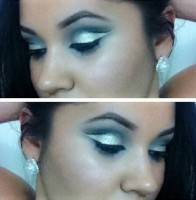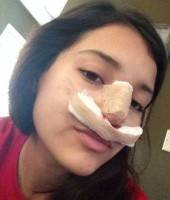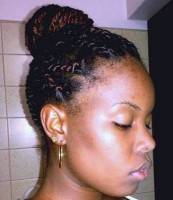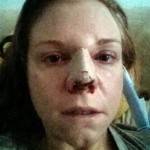Pixie Nose Rhinoplasty
Rhinoplasty (which some refer to as a “nose job”), is the most difficult of all facial cosmetic surgery procedures. The nose is the central feature on the face, yet an aesthetically pleasing nose is one that gets out of the way of the other facial features.
An attractive nose has a smooth transition from the arched medial eyebrow downward to the lateral nasal tip. The nose should not detract from beautiful eyes, lips, jaw lines, and smiles. When looking at someone’s face, the center of attention should not be drawn to the nose.
If the nose is the center of attention, then it is usually an unattractive nose. Correction of a nasal deformity or injury through Rhinoplasty or Revision Rhinoplasty restores the balance of the facial features.
Successful pixie nose surgery should result in a natural appearance, avoiding the obvious signs of a “bad nose job” (pinched tips, ski-slope profiles, or the dreaded “pig” nose tip, see the recent movie “Penelope”).
Additionally, the function of the nose should be the same or better after your pixie nose surgery. A board certified Rhinoplasty surgeon should be able to perform both closed Rhinoplasty (incisions inside of the nose) and an open or external approach (small incisions under the tip of the nose) depending upon what the individual nose demands.
The best chance for an excellent Rhinoplasty result is at the first surgical opportunity, but your surgeon should be familiar with performing Revision Rhinoplasty as well.
At your consultation for your Rhinoplasty or Revision Rhinoplasty surgery, computer imaging is very helpful to get an idea of how your nose will look after the Rhinoplasty surgery.
This will allow you to have a realistic expectation of your Rhinoplasty surgery results. At that time, you should also go over before and after photographs of previous patients.
All Rhinoplasty and Revision Rhinoplasty surgeries should be performed in a state accredited, outpatient surgicenter, or hospital with a board certified anesthesiologist.
Pixie nose surgery should take anywhere between 1 1/2 to 3 hours. I personally do not use “packing” inside the nose in 99% of my patients as this provides for a more comfortable recovery period. Many other surgeons prefer to routinely pack the nose for 2-5 days. After your Rhinoplasty surgery, you can expect your nose to be taped and splinted for five days. Most patients experience very little pain during their post-operative course.
Most patients state that it feels like a stuffy nose with slight sinus pressure, which can be relieved by plain Tylenol, if necessary. Most patients are able to return to their normal non-physical activities within one week, and return to normal physical activities after three weeks. The nose continues to improve over the next twelve months. (Michael A. Persky, MD, Encino Facial Plastic Surgeon)
Pixie nose surgery – seek a surgeon dedicated to nose surgery
I am often asked this question about a “specialist” for a particular procedure. As a plastic surgeon who does a fair amount of cosmetic pixie nose surgery I like to tell my patients that as in any procedure they are interested in they should find a surgeon that has dedicated a significant part of his practice to that particular procedure. I know of hardly any surgeons that just do one type of procedure.
I suggest to start by meeting the surgeon, getting a sense of his interest in the procedure, looking at the before/after of his past patients, and if available, speaking to past patients. That process will often give you most of the information you may need to make a good choice. (Sergio Pasquale Maggi, MD, FACS, Austin Plastic Surgeon)
Cannot say “a nose job is a nose job”
As a specialist in rhinoplasty, I would definitely not say that “a nose job is a nose job.” Like anything else, find a surgeon who does a fair number of them. You will more likely get the result that you seek, and if there are problems, more likely have the best chance at an optimal outcome in the event of revision surgery. (Manish H. Shah, MD, FACS, Denver Plastic Surgeon)
Specialist is a relative term when it comes to nose surgery
I have had the pleasure of reading the posts regarding your question. I agree with most of the posts. The term “specialist” is a relative term. There are many of us who consider ourselves specialists in the nose, both from the Facial Plastic Surgery group and from the Plastic Surgery group.
There are few of us who do only, or mostly noses in our practice. The other thing I agree with the most is to look for before and after pictures of noses that look like yours – some of the surgeons websites have the pictures separated by “type” or appearance. (Behrooz Torkian, MD, Beverly Hills Facial Plastic Surgeon)
Help for Pixie Noses
First and foremost, it is clear as others have stated already that you choose a board certfied plastic surgeon who is highly experienced with all types of noses. The more experience your surgeon has with difficult noses such as yours the less chance that you will have a need for revisions or major complications.
Complications can be aesthetic or functional (breathing issues). A pixie type nose requires carefully placed grafts and lengthening of the internal framework of the nose. These grafts must be secured and then the nose can be built up and shaped around them. There is no room for poor calculations in rhinoplasty. It is the MOST delicate operation we do as plastic surgeons.
It is sometimes helpful to google or research your doctor to see if he has written book chapters, lectured or written articles on this very specialized topic. Expertise is critical in rhinoplasty. (Ashkan Ghavami, MD, Beverly Hills Plastic Surgeon)
- Before Pixie nose surgery
- big nose pixie cut
- hannah pixie snowdon nose job
- pixie cut big nose
- pixie cut for flat nose
- pixie cut large nose
- pixie haircut big nose
- Pixie nose cut
- pixie nose prosthetics
- pixie nose shape recovery after surgery photo
- pixie nose shape surgery
- pixie nose shape what to do
Nature gives us noses of many shapes and sizes. Your nose is different from others but is in no way unique from other patients seeking pixie nose job.
As well, your self consciousness or other emotions, are in NO way different from the typical rhinoplasty patient. Your are definitely a great nose job candidate.
With good results your outlook should improve. I published a study on patients who had pixie nose job and showed that African American patients had a statistically significant increase in self esteem after rhinoplasty. Choose a good surgeon and realize your dream. (Oleh Slupchynskyj, MD, FACS, New York Facial Plastic Surgeon)
Do your homework and schedule a few consultations to evaluate your rhinoplasty surgeon
Choosing the right doctor is a complex decision that involves many issues. First make sure they are licensed and board certified. Check reviews. Meet with at least two and maybe three physicians to discuss your concerns. There are many physicians who specialize in rhinoplasty and you should not be afraid to ask. (Otto Joseph Placik, MD, Chicago Plastic Surgeon)
Plastic surgeons are trained in rhinoplasty or “nose-jobs”
All plastic surgeons are trained in rhinoplasty or “nose-jobs.” However, much fewer have additional specialized training or fellowships in rhinoplasty. It is important that you meet with the surgeon and talk to some of the other patients who have had surgery by him or her.
Most rhinoplasty surgeons do not specialize in a particular type of nose. However, some do concentrate more on secondary rhinoplasty (to correct the initial rhinoplasty from other surgeons).
So, if you do have a complicated nose, then it may be best to seek out one of these surgeons. In any case, it is important that you find a surgeon who you feel comfortable with and who spends the time to throughly examine your nose and explain the options to you. (David Shafer, MD, New York Plastic Surgeon)
Correction of pixie nose with rhinoplasty
A pixie nose is one form of nasal shape which occurs in nature. Most patients seeking nose job have large noses (large hump and large tip).
In your case, your nose is small. However, the principals of rhinoplasty surgery, whether it is reducing the nose or enhancing the nose, is the same. My recommendation is to find a surgeon who has an interest in pixie nose job surgery. To some degree, the number of cases performed and the amount of years the surgeon has been in practice, does matter.
However, quantity alone does not always correlate with quality. It is important to look at before and after photos, especially if there are photos similar to your nose. The term specialist can be used simply for marketing purposes. However, most surgeons will use this term to signify their interest in a particular area. Therefore, I think it is reasonable to search for surgeons who use this term. You can then narrow your choices from there. (Michael A. Jazayeri, MD, Santa Ana Plastic Surgeon)
A Nosejob Is a Nosejob
There are no specialists for each type of rhinoplasty. There are some who excel in ethnic noses. However, when it comes to a regular rhinoplasty all you want is someone who is really good with rhinoplasties. Get a few opinions, look at their results and then decide. Also make sure you discuss in exact words what your desires and expectations are. (Tanveer Janjua, MD, Bedminster Facial Plastic Surgeon)
You need to see a a facial plastic surgeon that specializes in rhinoplasties
Nasal surgery is a very complex operation and requires detailed planning by the surgeon followed by precise execution. This can only be performed correctly by a skilled surgeon specializing in this field. (Amir Moradi, MD, San Diego Facial Plastic Surgeon)
Pixie nose job – “The hardest Cosmetic Procedure for a Plastic Surgeon to Learn”
Because it takes many years of experience to learn how to perform a great looking Rhinoplasty, I would recommend you go to very experienced Plastic Surgeon. Of all the Cosmetic Procedures, with pixie nose job it is vitally important you seek out experience and expertise. (Christopher Costanzo, MD, Thousand Oaks Plastic Surgeon)
Get several opinions and look at lots of Rhinoplasty pictures. Steep learning curve in plastic surgery for nose jobs. You need to find a surgeon who has done many operations and good documentation of the results. Take your time and do your homework. (Vincent N. Zubowicz, MD, Atlanta Plastic Surgeon)
















